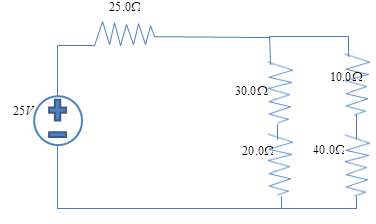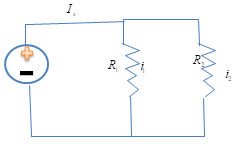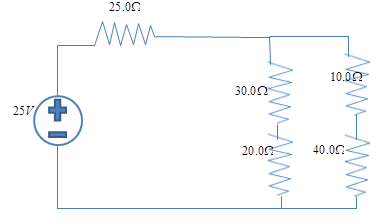
Using ohm's law, find the current through 25.0 ohm.
A. 1.0A
B. 1.5A
C. 0.5A
D. 2A
Answer
503.1k+ views
Hint: This question is based on the ohm's law, and the current division rule which is used to make the calculation easier. We will discuss both to get the answer. We will proceed by finding the source current first and then using the current division rule we will find the current through other elements of the circuit.
Complete step-by-step answer:

Ohm’s law states that the voltage or potential difference between two points is directly proportional to the current or electricity passing through the resistance, and directly proportional to the resistance of the circuit. The formula for Ohm’s law is V=IR. This relationship between current, voltage and relationship was discovered by German scientist Georg Simon Ohm.
Also , whenever current has to be divided among resistors in parallel, use current divider rule

$
{i_1} = \dfrac{{{R_2}}}{{{R_1} + {R_2}}}{i_s} \\
{i_2} = \dfrac{{{R_1}}}{{{R_1} + {R_2}}}{i_s} \\
$

Now the total resistance of the given circuit is
${\operatorname{R} _{eq}} = 25 + \dfrac{{50 \times 50}}{{100}} = 50$
Therefore, the current from the source end is given by
$
{I_s} = \dfrac{{{V_s}}}{{{R_{eq}}}} \\
{I_s} = \dfrac{{25}}{{25}} = 1A \\
$
As we have to find the current through the 25 ohm resistor, we know that the current in series remains the same and therefore the same source current will flow through the 25 ohm resistor.
Therefore the same source current will flow through the 25 ohm resistor.
Hence, the correct option is “A”.
Note- This law cannot be applied to unilateral networks. A unilateral network has unilateral elements like, diode, transistor, etc. Ohm's law is also not applicable for non - linear elements. Also the ohm’s law is only applicable to linear elements. An element is said to be linear if it satisfies the principle of homogeneity and superposition.
Complete step-by-step answer:

Ohm’s law states that the voltage or potential difference between two points is directly proportional to the current or electricity passing through the resistance, and directly proportional to the resistance of the circuit. The formula for Ohm’s law is V=IR. This relationship between current, voltage and relationship was discovered by German scientist Georg Simon Ohm.
Also , whenever current has to be divided among resistors in parallel, use current divider rule

$
{i_1} = \dfrac{{{R_2}}}{{{R_1} + {R_2}}}{i_s} \\
{i_2} = \dfrac{{{R_1}}}{{{R_1} + {R_2}}}{i_s} \\
$

Now the total resistance of the given circuit is
${\operatorname{R} _{eq}} = 25 + \dfrac{{50 \times 50}}{{100}} = 50$
Therefore, the current from the source end is given by
$
{I_s} = \dfrac{{{V_s}}}{{{R_{eq}}}} \\
{I_s} = \dfrac{{25}}{{25}} = 1A \\
$
As we have to find the current through the 25 ohm resistor, we know that the current in series remains the same and therefore the same source current will flow through the 25 ohm resistor.
Therefore the same source current will flow through the 25 ohm resistor.
Hence, the correct option is “A”.
Note- This law cannot be applied to unilateral networks. A unilateral network has unilateral elements like, diode, transistor, etc. Ohm's law is also not applicable for non - linear elements. Also the ohm’s law is only applicable to linear elements. An element is said to be linear if it satisfies the principle of homogeneity and superposition.
Recently Updated Pages
Master Class 12 Economics: Engaging Questions & Answers for Success

Master Class 12 Maths: Engaging Questions & Answers for Success

Master Class 12 Biology: Engaging Questions & Answers for Success

Master Class 12 Physics: Engaging Questions & Answers for Success

Master Class 12 Business Studies: Engaging Questions & Answers for Success

The correct geometry and hybridization for XeF4 are class 11 chemistry CBSE

Trending doubts
The gas that burns in oxygen with a green flame is class 12 chemistry CBSE

The probability that a leap year will have only 52 class 12 maths CBSE

Describe the poetic devices used in the poem Aunt Jennifers class 12 english CBSE

And such too is the grandeur of the dooms We have imagined class 12 english CBSE

What does the god that failed refer to class 12 english CBSE

Which country did Danny Casey play for class 12 english CBSE




